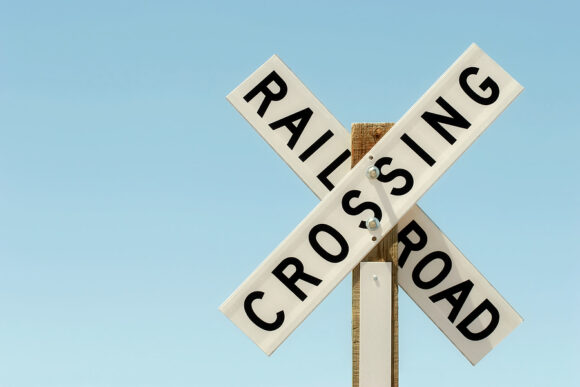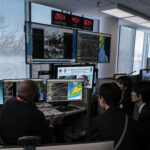The rural communities of Fairmount and Lidgerwood, N.D., are flanked by mainline rail systems, while Hankinson is dissected by a major rail line. Train traffic is an everyday occurrence there, which carries a certain degree of risk when motorists pass over these often-used tracks.
Having the Hankinson Renewable Energy LLC plant in Hankinson, Horizon Milling flour mill in Fairmount and numerous agricultural businesses sprouting alongside rail tracks, it isn’t likely the number of trains passing through area communities will decrease any time soon, especially when you factor the amount of product passing through from the western North Dakota oil fields.
 Train intersections have become a safety issue with the recent fatal accident that occurred between a train and motorist near Sabin, Minn. That accident claimed the life of a 91-year-old man when William Briden died at the scene Feb. 2 at an unmarked intersection along Clay County Road 67. His wife, Gloria Briden, was driving just yards from their home.
Train intersections have become a safety issue with the recent fatal accident that occurred between a train and motorist near Sabin, Minn. That accident claimed the life of a 91-year-old man when William Briden died at the scene Feb. 2 at an unmarked intersection along Clay County Road 67. His wife, Gloria Briden, was driving just yards from their home.
Lidgerwood Mayor Steve Oddo said he is concerned about motorist safety.
“We have one track real close to (N.D.) 11, so if you’re coming in from the north side of town, people have a tendency to slow down for the stop sign and don’t know they’re stopping on the tracks,” he told the Daily News of Wahpeton.
Lidgerwood residents heading to the town dump only have a stop sign to halt their progress before crossing the tracks. That is a safety issue, Oddo said.
“I have a problem with unprotected intersections. I want to see crossbars at every intersection in small towns,” he said.
Mayor Joe O’Meara said he thinks the numerous trains passing through Hankinson are one of the reasons there have been few safety issues in town. O’Meara said he isn’t overly worried about motorists getting into trouble here because Hankinson requires a maximum speed of 25 miles per hour for trains and motorists.
“I think one of the reasons it is safe is because those arms come down a lot so people here are very aware of the trains. When we have such high traffic, motorists are always looking for a train,” O’Meara added.
Lidgerwood has a train crossing on the city’s north side, just north of the N.D. 11 and N.D. 18 junction. There are crossbars located at the intersection and advance signs signaling an upcoming railroad intersection.
Fairmount also has a high traffic count with trains since Horizon Milling is located on the city’s western edge. The rail lines intersect with N.D. 127 at Fairmount and have advance warning systems in place with crossbars and signs. There are two marked intersections in Fairmount, and both have crossbars, said Mayor Jon Nelk. But is it adequate? Nelk doesn’t think so. He would like to see signage with flashing lights installed a quarter mile in both directions alerting motorists about the upcoming train intersection. With traffic speeds on N.D. 127 going 65 mph or higher, motorists in poor weather conditions may not see the flashing lights of the crossbars until it is too late, he said.
Nelk has heard about a fatal accident that occurred in Fairmount years ago, something city residents still talk about. In more recent years, he said there have not been any issues.
“There is respect for the train. Locally, with the traffic we have, there is a respect issue,” he added.
Hankinson is spread out about a mile in diameter and has two crossings in town, both of which are supported by advance warning systems that include crossbars and signage. O’Meara said having a mainline rail system is something city residents have gotten used to, so motorists tend to spend a lot of time waiting for trains to pass. The biggest issue regarding safety is motorists trying to beat the train. The two crossings are about a half-mile apart, so it isn’t such a quick matter as driving around the block to beat a train, so if no one is crossing at the other intersection, motorists just tend to stay put, he said.
“I would be more concerned if we had multiple crossings. With the crossings we have here and the arm systems that were installed, we have it pretty good here,” O’Meara said.
There are various railroad intersections in rural Richland County that do not have crossbars, which could pose potential problems, Richland County Sheriff Larry Leshovsky said. Safety hasn’t been a big issue here because most people are aware of the rural tracks. Richland County has had a minimal number of accidents through the years. He said if there is a concern, the county contacts the railroad and new signage or crossbars are installed.
“The area railroads have been very responsive,” Leshovsky said.
There was an issue with a rail line at the intersection of N.D. 11 and N.D. 18 near Lidgerwood. A stop sign was located close to the tracks so long vehicles such as semitrailers and buses that stopped because of the sign didn’t know the back of their vehicle was still on the tracks, so a sign was installed to alert drivers about this hazard.
Leshovsky said the biggest concern for public welfare is complacency.
“Driving over railroad tracks could be part of someone’s normal routine. They may have gone over the tracks 1,000 times and no train, and all of a sudden there is a train” and the motorist isn’t prepared to stop, he said. He warned motorists to keep a careful lookout for trains, especially at unmarked intersections. Leshovsky said all paved roads and major highways have advance warning signs and crossbars in Richland County.
Red River Valley and Western Railroad operates 520 miles of track from its home base of Wahpeton-Breckenridge. Every road that intersects with the RRV&W line has advance signs 200 feet in front of the intersection, and crossbucks, said President Andy Thompson. These safety standards have been in place since the rail line went into operation 26 years ago, Thompson said. RRV&W trains also operate at 25 miles per hour.
Thompson said he doesn’t have annual statistics regarding near misses with the RRV&W trains, but he said engineers report the biggest safety issue is people trying to beat the train, or motorists not paying attention.
“There are a lot of distractions out there, with cellphones, GPS, radios, eating, drinking and other things that people do when they are trying to drive. It’s hard to focus on driving,” Thompson said.
Was this article valuable?
Here are more articles you may enjoy.


 Family of Canadian CEO Killed in Helicopter Crash Files $35 Million Lawsuit
Family of Canadian CEO Killed in Helicopter Crash Files $35 Million Lawsuit  France Fines Apple $162M Over iOS Data Tracking Consent
France Fines Apple $162M Over iOS Data Tracking Consent  VW, Stellantis, Renault Among Firms Fined $495M Million by EU
VW, Stellantis, Renault Among Firms Fined $495M Million by EU  US Weather Service Merges Units as Staffing Pressure Rises
US Weather Service Merges Units as Staffing Pressure Rises 